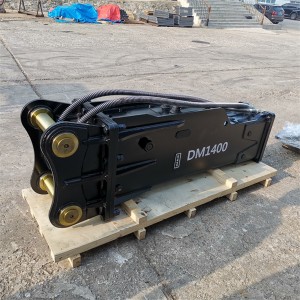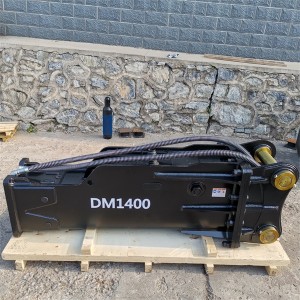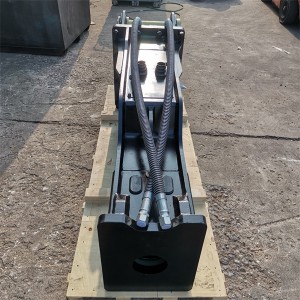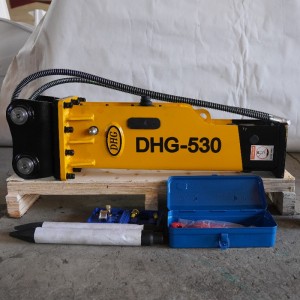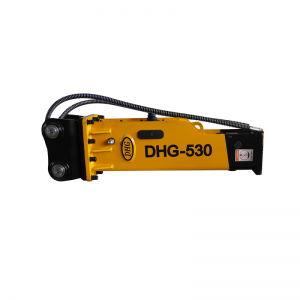SB81 Model Hydraulic Box Type Silence Rock Breaker Hammer Demolition Hammer Breaker
Hydraulic breakers and rock hammer attachments for excavators
Just like the power tools you have at home, the more versatile a piece of industrial equipment is the better. Stationary booms, backhoes, skid steers, and even forklifts are designed to serve a variety of uses along with their primary purpose. It all comes down to how you equip the machine.
Excavators are one of the more adaptable pieces of equipment in this respect. In addition to the buckets used to scrape or dig into the earth, augurs, compactors, rakes, rippers, and grapples can be attached for specific jobs. Like a Swiss Army knife, if there’s a job that needs to be done, the excavator probably has an attachment for it.
Hydraulic Hammers/Breakers
There are times when an obstacle prevents normal excavation from occurring. Used in mining, quarries, excavation, and demolition, the hammer/breaker is brought in to chip away at large boulders or existing concrete structures. There are times when blasting is used to remove obstacles or breakthrough thick layers of rock, but hammers offer a more controlled process.
Breakers are driven by a hydraulic piston that exerts pressure on the head of the attachment to provide a powerful and consistent thrust into the obstruction. In simplest terms, it’s just a really big jack hammer. Great for tight spaces and continuous production, breakers are also much quieter and create less vibration than blasting.
DHG hydraulic breakers are designed to be compact and easy to handle, allowing them to be operate in a variety of groundwork, demolition and mining applications. Optimum efficiency and performance is achieved with highly reliable design and enabling easy ongoing servicing. These hammers are suitable for a vast range of tool carriers and are most commonly fitted to excavators, backhoe and skid steers, but can also be mounted to any other carrier with sufficient oil flow, allowing you to get the job done quickly, safely and economically.
As with all machinery, the breaker should be inspected before and after every use to ensure good working conditions. Unusually worn components should be addressed and the operator needs to make sure the proper amount of lube or grease is being used. During operation, make sure the following processes are followed for safety. For the tool, the operator, and other personnel in the area, make sure to consult the users manual for correct operation.
Hydraulic Breaker Specification
| Model | Unit | BRT35 SB05 |
BRT40 SB10 |
BRT45 SB20 |
BRT53 SB30 |
BRT68 SB40 |
BRT75 SB43 |
BRT85 SB45 |
BRT100 SB50 |
BRT135 SB70 |
BRT140 SB81 |
BRT150 SB100 |
RBT155 SB121 |
BRT 165 SB131 |
BRT 175 SB151 |
| Total Weight | kg | 100 | 130 | 150 | 180 | 355 | 500 | 575 | 860 | 1785 | 1965 | 2435 | 3260 | 3768 | 4200 |
| Working Pressure | kg/cm² | 80-110 | 90-120 | 90-120 | 110-140 | 95-130 | 100-130 | 130-150 | 150-170 | 160-180 | 160-180 | 160-180 | 170-190 | 190-230 | 200-260 |
| Flux | l/min | 10-30 | 15-30 | 20-40 | 25-40 | 30-45 | 40-80 | 45-85 | 80-110 | 125-150 | 120-150 | 170-240 | 190-250 | 200-260 | 210-270 |
| Rate | bpm | 500-1200 | 500-1000 | 500-1000 | 500-900 | 450-750 | 450-950 | 400-800 | 450-630 | 350-600 | 400-490 | 320-350 | 300-400 | 250-400 | 230-350 |
| Hose Diameter | in | 1/2 | 1/2 | 1/2 | 1/2 | 1/2 | 1/2 | 3/4 | 3/4 | 1 | 1 | 1 | 5/4 | 5/4 | 5/4 |
| Chisel Diameter | mm | 35 | 40 | 45 | 53 | 68 | 75 | 85 | 100 | 135 | 140 | 150 | 155 | 165 | 175 |
| Suitable Weight | T | 0.6-1 | 0.8-1.2 | 1.5-2 | 2-3 | 3-7 | 5-9 | 6-10 | 9-15 | 16-25 | 19-25 | 25-38 | 35-45 | 38-46 | 40-50 |


